The king did not even hide the fact that he was not able to be in the company of his wife. Jadwiga was forever lonely and despised. Her relationship with Jagiełło turned into a series of quarrels, excuses and complaints.
The Teutonic Knights and the Habsburgs did not mince their resources, waging a massive campaign against Queen Jadwiga all over Europe. A teenage ruler who, for the sake of the country and Christianity, agreed to marry a prince from pagan Lithuania, was accused of bigamy, called shameless women and prostitutes (I already wrote about all of this in another article) .
The disgusting attacks made even the pope himself think, and a trial was launched against Jadwiga in the apostolic curia. The accusations also reached Jagiełło's ears. Instead of standing behind his wife, he quickly joined the chorus of accusers.
War of words
As early as 1388, that is a dozen or so months after the wedding, the king started making scenes of jealousy for his wife. He accused her that she had lied to him and that he was not her first, because she had invited William to bed before. Nay. He probably insinuated that Jadwiga - according to the circulating dyrdymałami - despises him, disgusts the rapprochement with her husband, that she longs for others in her heart.
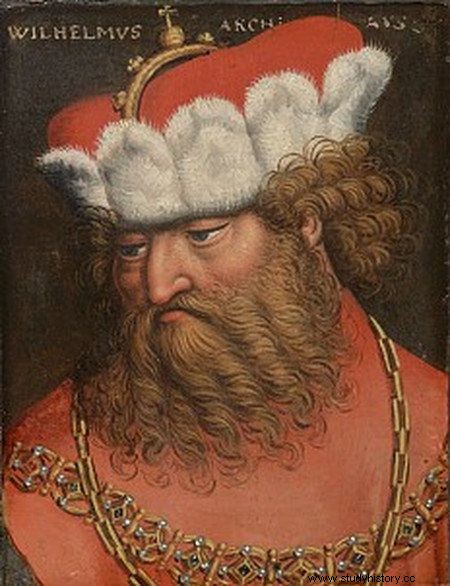
Wilhelm Habsburg. He considered his would-be partner a prostitute and adulteress. Plus, he was spreading nasty lies about her.
The dispute between the spouses was eased, but it returned a year later with redoubled strength. Neither side trusted the other anymore. Jagiełło accused his wife of abusing him and that he disgusted him in his heart. Jadwiga was reprimanding the king's lovers. And, taking into account the customs of the epoch, these were probably not unsubstantiated accusations.
I didn't know anyone's bedside except my husband
The growing conflict between the king and queen became a court sensation. But it was also a breeding ground for risk takers ready to play off the monarchs' animosities for their own needs. According to Jan Długosz, one of the cynical types suggesting Jadwiga's worst thoughts about his spouse (and Jagielle - rumors about his wife's bad conduct) was a certain Gniewosz from Dalewice. And it was he who felt that it was not proper to get involved in the ruler's domestic quarrels.
Offended Jadwiga, whom Gniewosz was supposed to openly slander in front of Jagiełło, brought her own lawsuit against the knight. The queen was represented by the castellan of Wojnicz, Jasko of Tęczyn, "convinced by the oath and the queen's assurance that she knew no one except her husband , King Władysław ". Twelve knights stood behind her, announcing that they were ready to defend Jadwiga's honor with their weapons in hand and challenge to a duel anyone who dares to offend the monarch.
Frightened and herded into a corner, Gniewosz remained silent throughout the whole trial. He opened his mouth only once, pleading for a lenient sentence from the judges. He also received that. He was not beheaded with a sword or thrown into a dungeon. Instead, he was to crawl under the table and "immediately, in front of the tribunal, bark back, like a dog, slanders uttered shamelessly to disgrace the honor of the Queen."
In fact, Gniewosz bent his back, stepped under the bench and "openly testified that it was a falsehood and a wicked creature, which he had lied against Queen Jadwiga." Finally - to the amusement of the gathered people, the satisfaction of the ruler and the disgrace of her own family - "barked loudly".
Bed problems
Jan Długosz was convinced that with the passing of the sentence in the trial of the knight from Dalewice, all the disputes between the spouses ended. As he wrote:
Queen Jadwiga's fame and innocence were saved, a divergent marriage was reconciled, and all rebels and henchmen were feared lest they dare to quarrel and incite one spouse against another. Since then, the king and the queen, far from any suspicions and disputes, lived in stable harmony and blissful sweetness full of love.
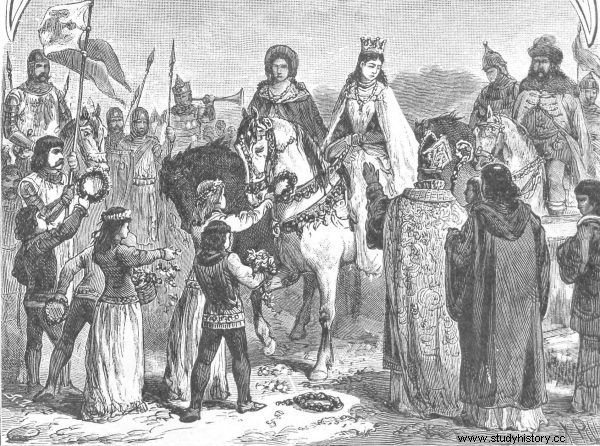
The entry of ten-year-old Jadwiga to Poland in 1384. A drawing by Ksawery Pillati.
However, the relationship between Jadwiga and Jagiełło was not a fairy tale, and the crowned spouses did not live behind seven mountains and seven forests. If the royal marriage was shaken by such a serious crisis, its foundations must have lay much deeper than just the unfavorable rumors spread by the Habsburgs and Teutonic Knights.
It's hard to find details, but it seems that it was in the bedroom that did not go the way of the royal couple. It could be about differences in temperament, physical mismatch, or about the lack of readiness of Jadwiga, still very young, about fifteen years old, to be Jagiełło's wife in every sense.
Finally, it is possible that the queen, even if subconsciously, took all these attacks and insinuations personally. She felt dirty, and the thought of associating with Jagiełło - or any man in general - disgusted her. However, no fruit was born from the union of the royal couple. Immediately after the wedding, no one was surprised. The queen did not get pregnant, however, in 1385 or in any of the following years.
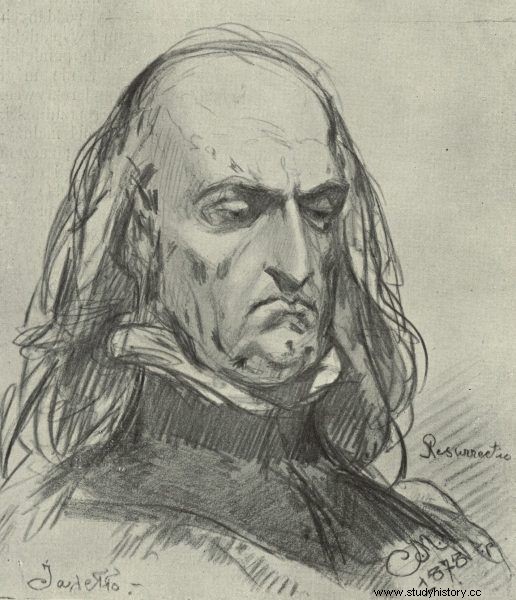
Władysław Jagiełło in an unpublished sketch by Jan Matejko.
Long distance relationship
Moreover, there were few opportunities to apply for an extension of the family. The spouses lived not so much with each other as next to each other. It must have been quite a surprise for Jadwiga. Her grandparents, Elżbieta Łokietkówna and Karol Robert, even if they did not like each other, were respectful enough to eat each meal together at the same table. His parents, Ludwik Andegaweński and Elżbieta Bośniaczka, did the same.
Dinners were an opportunity for family meetings, for talks between spouses and for establishing closer relationships with children. Meanwhile, at Wawel, Jagiełło and Jadwiga offered at most the possibility of building wire entanglements.
It is not known if any prior tradition supported this, but the king and queen consistently ate separately. At other tables, and even in separate rooms. Jagiełło sat down to a meal with only men; their associates and officials. Meanwhile, Jadwiga dined in the company of the court maid and the most important ladies. For the other ladies from the fraucimer, a second, not so richly set table was placed next to it.
The gender division was all the more important as feasts were key items on the agenda for the entire castle day. These were not snacks swallowed on the run, but unhurried meetings where the act of eating was celebrated, often sitting over the bowls for hours.
The runaway king
The very absence of Jadwiga at Jagiełło's table meant that the queen was also largely absent from his life. During the king's visits to Wawel, the spouses could at least pass each other in the palace corridors or - meet at night, in the alcove. The thing is, however, that the king hated the Krakow residence and did everything to avoid it.
Having left for Lithuania immediately after his coronation, in fact, he never returned to the capital and did not settle there permanently. He constantly changed places, was constantly on the way, prepared for it or rested after the journey. He was said to be a "rex ambulance", the traveling king. Jadwiga, however, would rather say that he is a fugitive king. Because her husband was never there when she needed him.
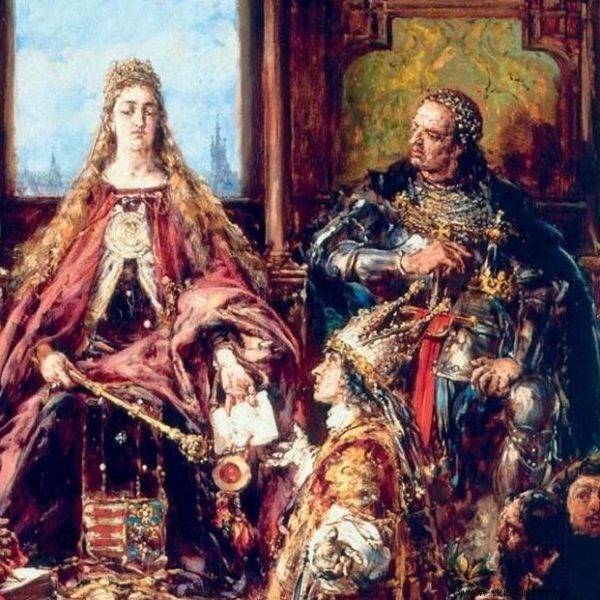
Jadwiga and Jagiełło in the painting by Jan Matejko.
Even if he happened to visit Wawel, after a week or two it was itching for him to go somewhere further. He made excuses, made excuses, and did not even hide that he was unable to be with his wife.
In effect, running a house, which was both a center of power and a symbol of the kingdom, was on the monarch's head. It was she who breathed new life into Wawel, almost abandoned for many years of interregnum. She also explained to her husband whenever he disappeared at the most inopportune moment.
In 1390, he sneaked out of Wawel, first inviting his brother Skirgiełła, an unknown niece by name, and a whole crowd of guests who were to witness the girl's baptism. Maybe he couldn't stand the boring games, small talc and court entertainment anymore. Or maybe - as some historians suspect - he had an argument with his wife and, offended, literally escaped on the eve of the scheduled baptism. Whatever it was - Jadwiga was shining her eyes behind him.
Fiction of marital intercourse
She constantly took care to keep alive even the fiction of a healthy marriage. Hearing that her husband was approaching Krakow, she went out to meet him, organized greetings and waited. Sometimes she had to stay in this or that provincial palace for weeks, because Jagiełło - with his custom - delayed his arrival, dodged and changed his plans, disregarding his wife at all.
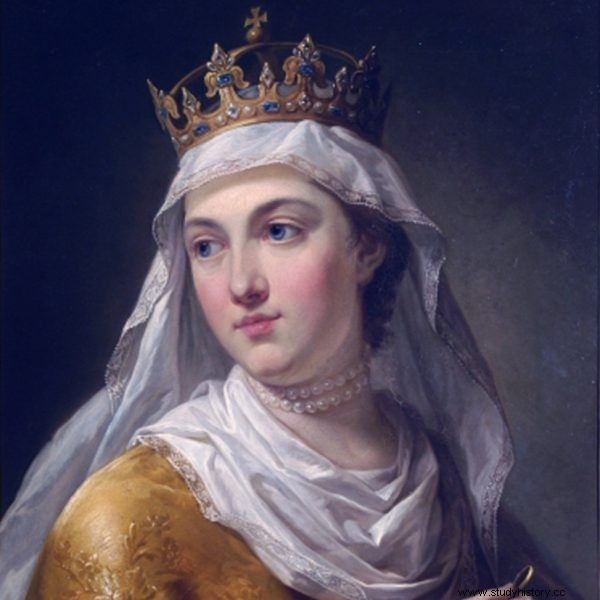
Queen Jadwiga. Portrait by Marcello Bacciarelli.
On other occasions it had to wander back and forth. For example, she was going to Korczyn only to return to Wawel a day later, having received news that her husband would not be coming. Jagiełło put her to the wind on Christmas, Easter, and on wedding anniversaries. And even if they were spending Christmas together, it was not in one room, let alone having fun together.
Throughout 1394, best lit by the preserved documents, the spouses spent only 57 days together. In other years, there were even fewer meetings, and yet their number does not reflect the true scale of contacts between Jadwiga and Jagiełło.
The fact that the spouses were in one town or even in one palace did not make them really together. Besides, there weren't even any entertainment they could (or would like) to participate in together. Take, for example, knightly tournaments. They aroused astonishment and impatience in Jagiełło. Meanwhile, Jadwiga passionately supported the knights who competed. It even happened that a whole series of tournaments was organized especially for her by a lessee of the Bochnia salt mine, a certain Winko.
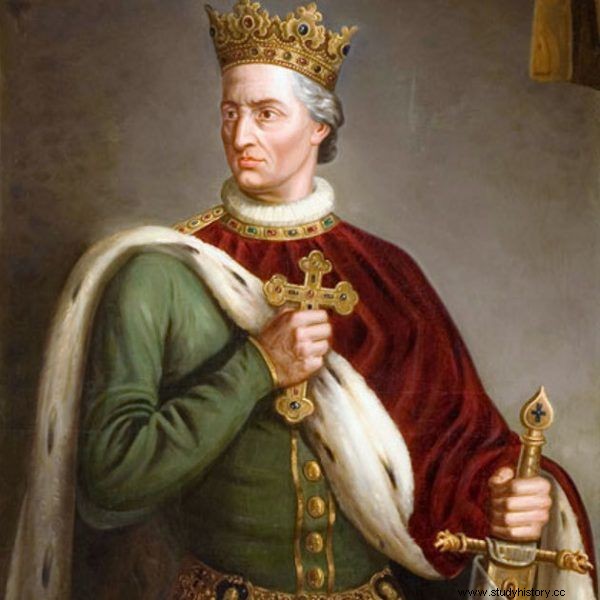
Władysław Jagiełło in the painting by Michał Godlewski.
The school of indifference
The older Jadwiga was, the better she understood that she was completely indifferent to her husband. Jagiełło did not feel affection for his wife, but only empty phrases about respect and affection. He couldn't even bring himself a valuable gift for her. He always gave his beloved sister Aleksandra (married to Siemowit IV, ruling in Mazovia) in the first place, and only then did he think about making Jadwiga a trinket. The Queen - aware of rejection and contempt - was painfully lonely.
But to a large extent it was this loneliness that aroused in her ambition and the desire to take matters into her own hands. With each passing year, she became more and more not only the wife of her ever absent husband, but also a true queen. And even, according to its title, a full-fledged king.
***
This is just the very beginning of the fascinating story of a woman who - contrary to the wishes of her parents and the expectations of her surroundings - was to become not only a queen, but even a king. You can read more about Jadwiga Andegaweńska and other extraordinary ladies of this era in my new book: “Ladies of the Polish Empire. Women Who Built a Power " .
Selected bibliography:
The article was based on materials collected by the author during the work on the book "Ladies of the Polish Empire. The Women Who Built a Power " . Some of these items are shown below. Full bibliography in the book.
- Biedrowska-Ochmańska K., Ochmański J., Władysław Jagiełło in the opinions of his contemporaries. An attempt to characterize his personality , University of Adam Mickiewicz, Poznań 1987.
- Halecki O., Jadwiga Andegaweńska , Universitas, Krakow 2000.
- Kellog C., Jadwiga. Poland’s Great Queen , Macmillan, New York 1931.
- Kręt H., Silhouette of św. Jadwiga Król in the light of accounting records , "Bulletin of the Jagiellonian Library", vol. 49 (1999).
- Kręt H., The Daily Life of Jadwiga and Jagiełło , WAM, Krakow 2005.
- Krzyżaniakowa J., Ochmański J., Władysław II Jagiełło , Ossolineum, Wrocław 2006.
- Kuczyński S.M., King Jagiełło around 1351–1434 , Publisher of the Ministry of National Defense, Warsaw 1985.
- Kwaśnicka M., Jadwiga , Saint Nicholas Foundation / Redaction of "Teologia Polityczna", Warsaw 2015.
- Maciejewska W., Jadwiga, the Polish queen , Krakow 1934.
- Nikodem J., Gniewosz - Jadwiga - Wilhelm. Criticism of the message "Annales" by Jan Długosz , "Przegląd Historyczny", vol. 98 (2007).
- Nikodem J., Jadwiga, King of Poland , Ossolineum, Wrocław 2009.
- Osiński K., The marriage of Jadwiga Andegaweńska with Władysław Jagiełło in Annals of Jan Długosz , "Przegląd Prawniczy Ekonomiczny i Społeczny", vol. 2 (2014).
- Przybyszewski B., Jadwiga and Wilhelm , "Analecta Cracoviensia", vol. 7 (1975).
- Rybska K., Wives of Władysław Jagiełło in the eyes of Jan Długosz [in:] In the footsteps of Saint Queen Jadwiga and her era , ed. T. Graff, Parish pw. st. Jadwigi Królowej, Krakow 2013.
- Sroka S.A., Królowa Jadwiga , WAM, Krakow 2002.
- Strzelecka A., Jadwiga Królowa [in:] The work of Jadwiga and Jagiełło , comp. W. Biliński, Publishing House of the Archdiocese of Warsaw, Warsaw 1989.
- Wyrozumski J., Królowa Jadwiga. Between the Piast and Jagiellonian eras , Universitas, Krakow 2006.
